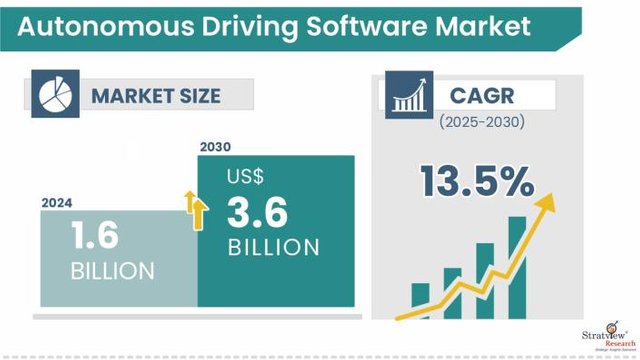The Impact of Autonomous Driving Software on the Global Automotive Market
Autonomous driving software is rapidly reshaping the global automotive market. As self-driving technology advances, automotive software has become a central component in the development of autonomous vehicles. With growing consumer demand for advanced driving features and increased safety standards, the market for autonomous driving software is expanding.
Stratview Research predicts that the autonomous driving software market will grow at a CAGR of 13.5%, reaching USD 3.6 billion by 2030.
Download the sample report here, to uncover in-depth insights.
https://stratviewresearch.com/Request-Sample/4113/autonomous-driving-software-market.html#form
 The Role of Autonomous Driving Software
The Role of Autonomous Driving Software
1. Enhanced Vehicle Safety:
One of the primary reasons for adopting autonomous driving software is to improve vehicle safety. By reducing human error, autonomous vehicles can significantly decrease the likelihood of traffic accidents and road fatalities.
2. Increased Efficiency and Fuel Savings:
Autonomous driving software optimizes vehicle performance, making it more efficient. It can enhance fuel economy by adjusting speed and acceleration patterns, which leads to reduced fuel consumption.
3. Changing Consumer Preferences:
As consumers embrace connected technologies and intelligent systems, demand for autonomous driving features is increasing. Autonomous driving software meets this demand by offering smart features such as self-parking, automated navigation, and driverless control.
Market Drivers for Autonomous Driving Software
1. Technological Advancements in AI and Machine Learning:
AI and machine learning algorithms are key drivers of the autonomous driving software market. These technologies allow vehicles to analyze and interpret real-time data, enabling autonomous vehicles to make decisions based on changing environments.
2. Global Regulatory Push for Autonomous Vehicles:
Governments are investing in autonomous vehicle infrastructure and developing regulations that support the safe and efficient deployment of autonomous vehicles. This support is helping to accelerate the adoption of autonomous driving software worldwide.
Challenges in Autonomous Driving Software
1. Technological Limitations:
Despite advancements in software and sensors, autonomous driving technology still faces significant technological limitations. Factors like weather conditions, complex urban environments, and sensor accuracy present challenges to the widespread adoption of self-driving vehicles.
2. Data Privacy Concerns:
Autonomous vehicles rely heavily on data from sensors, GPS systems, and cloud computing. The management of this data raises concerns about data privacy and cybersecurity, which need to be addressed to build consumer trust in autonomous driving systems.
Conclusion
The autonomous driving software market is poised for significant growth as the demand for safe, efficient, and connected vehicles rises. With advancements in AI, sensor technologies, and data analytics, autonomous vehicles will continue to evolve, offering more intelligent, safe, and sustainable transportation solutions.